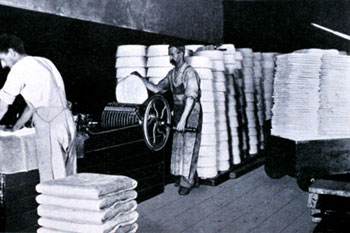Making Candles
Spermaceti, a liquid taken from the head of sperm whales, was processed in a similar manner as other whale oil. The significant difference was that it did not have to be "tried out" on board the whale ship. Instead, seamen ladled this yellowish liquid directly into barrels. Once outside the whale’s body, spermaceti crystallized into a milky-white waxy mass. Barrels of this head matter were delivered to candleworks manufacturers that sprang up along the New England Coast. In the early 1830s, a local surveyor counted eight candleworks in New Bedford alone.
The repeated process of heating and pressing spermaceti left behind a brittle, dry wax. This brownish substance was melted yet again. A mineral called potash was added to remove the unwanted color. After the additive boiled out of the liquid, the pure wax was doused with water and impurities that floated to the surface were removed. The highly refined spermaceti was finally poured directly into candle molds or larger metal tins for later use
The very finest whale oil was pressed out of spermaceti. It burned the brightest and cleanest. Spermaceti also produced the finest candle wax. Benjamin Franklin, among other wealthy customers, appreciated that spermaceti candles did not melt in warm weather, burned very slowly, and provided superior light. These pearly white candles did not make grease spots when they dripped and required little or no snuffing. The finest candles at fancy dinner parties would have been made from sperm oil.

National Oceanic and Atmospheric Administration